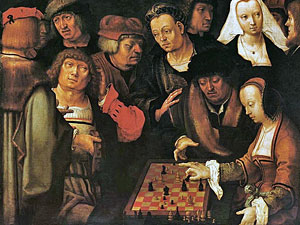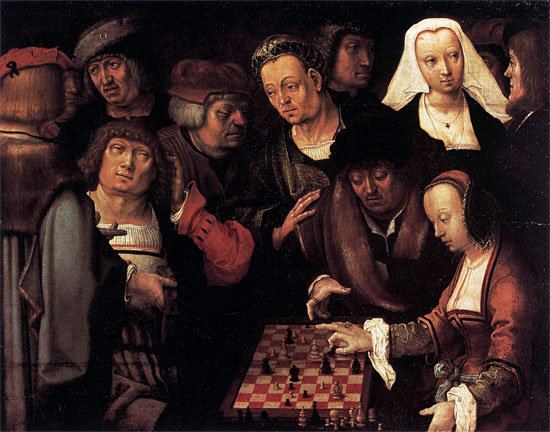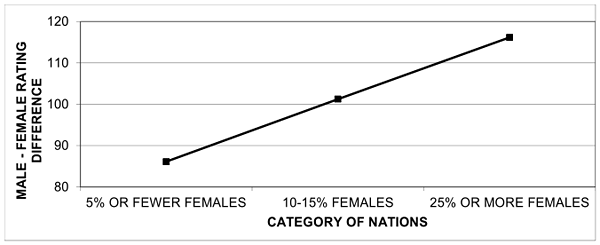


Males predominate at the top in chess. Almost all grandmasters are male, there never has been a female world champion and only one female, Judit Polgar, ever has reached the top ten in the FIDE rating list (eighth spot in 2005 with a peak rating of 2735).
The male predominance in chess parallels that in domains such as mathematics, physics and engineering, which may tap some similar abilities and propensities. Carrying out research in high-level, competitive areas of physics and mathematics or playing a grandmaster-level game can greatly tax physical stamina and ability to concentrate and can strain the processing limits of our monkey brains, which evolved to carry out much simpler tasks. These areas also all rely partly on spatial ability, the power to visualize objects in space and to mentally manipulate the images. This ability is important in chess calculation, for instance. In the endgame, players may calculate variations 20 moves deep, relying on spatial ability to visualize the changes. Players may picture a position some moves down the line, analyse it extensively, and then work out how to reach it.

This painting by Dutch artist Lucas van Leyden (1494–1533) very aptly illustrates our subject
Various explanations have been proposed for the female under-representation at the top in chess and in science and technology areas. Some researchers say that it is all due to social factors. There are no ability or personality differences between the sexes. Instead, social pressures discourage women from being competitive and from outdoing men, women face “stereotype threats” that males have more talent, and old boys networks downplay female achievement and limit female opportunity.
Evolutionary psychologists counter that natural selection pressures on the sexes of a species may differ and may create some differences in abilities and propensities. Consider a battle-scarred male beach master sea lion on a sub-Antarctic island in mating season, guarding a harem of 20 females. He continually must fend off other males sneaking in to try to mate and there is natural selection for beach master size, ferocity, stamina, and competitiveness. Female sea lions do not need to compete for mates in the same way and so sex differences arise over time. For instance, male sea lions became much physically larger and more ferocious than females.
The argument goes that in hunter-gatherer times, there were natural selection pressures on human males for better spatial ability, competitiveness and related factors. Females also are more important in evolution because few males are needed to produce the next generation. Nature can experiment more with them and males show more variability in many traits. There are more males at both extremes of the IQ distribution, for example.
Chess talent may consist of a mix of ability and personality traits at which males on average may excel or there may be more males at the top extreme due to greater male variability. These factors may include high IQ (to learn chess material quickly and to understand complex concepts such as opposite colored bishops endgame and tactically unbalanced position), and spatial ability, ability to concentrate, and competitiveness. Stars in chess and in physical sports often have the famed “killer instinct”, the desire to win at all costs.
In 2005, I published a study which aimed to quantify the male/female FIDE rating difference at the top and to see if the gap had diminished with all the societal changes in the role of women over the period and with the increasing number of female grandmasters (31 in January, 2014). I looked at the top 50 male players and top 50 female players in the first FIDE rating list each year from 1975 to 2004. I have extended the resulting graph for an additional ten years and the results are shown below. The sex difference averages nearly 250 rating points (about a hefty one standard deviation for the statistically minded) and has remained roughly constant over the four decades.

But the 2005 study had two interpretation problems. I found that women typically play many fewer FIDE-rated games than males, only about one third of the number on average. Now, the usual learning curve for chess players is a progressive ascent to a peak at around 750 FIDE-rated games. Most players who persist to 900 rated games become grandmasters but few play so many games. Women tend to drop out much earlier and perhaps most would have become grandmasters if they had persisted to 900 games. Comparing modestly- and highly-practiced individuals can be misleading. Studies should control for differences in number of games played, either by equating males and females on this or by examining differences at the typical rating peak at around 750 games.
But when this is done, the male predominance remains. The figure below illustrates this. As noted, for some traits males show more variability. There are more males at both IQ extremes. In other traits, such as height and spatial ability, the male mean also is higher. I examined the rating distributions for males and females at about 750 FIDE-rated games played, looking at all males and females who had played 750 games by January 2012. With differences in games played thus controlled for and with players near their performance limits, the male distribution still shows a higher mean and more variability, exactly as with spatial ability and height.

The other interpretation problem is that many fewer women play chess. Look at the playing hall at an open tournament and the usual severe under-representation of women becomes apparent. In January 2012, only about 8.51% of FIDE-rated players were female. The “participation rate hypothesis” proposed by some researchers holds that the sex difference at the top in chess arises simply because so many more males play and statistically there are likely to be fewer females at the top due to their under-representation.
For instance, a study by a team led by Merim Bilalic, then of Oxford University, looked at the April 2007 German Chess Federation rating list, on which only 5.82% of the players were female. The team argued that the percentage of top-rated females on this list was about what would be expected statistically from this tiny percentage of 5.82.
|
Why are (the best) women so good at chess? By Merim Bilalic, Kieran Smallbone, Peter McLeod and Fernand Gobet A popular explanation for the small number of women at the top level of intellectually demanding activities from chess to science appeals to biological differences in the intellectual abilities of men and women. An alternative explanation is that the extreme values in a large sample are likely to be greater than those in a small one. Although the performance of the 100 best German male chess players is better than that of the 100 best German women, we show that 96 per cent of the observed difference would be expected given the much greater number of men who play chess. There is little left for biological or cultural explanations to account for. In science, where there are many more male than female participants, this statistical sampling explanation, rather than differences in intellectual ability, may also be the main reason why women are under-represented at the top end. |
Problem solved? The study featured on the German ChessBase website in 2009 and in newspaper reports around the world, with grave tones of finality. This study settles the issue for good. There are no differences in chess talent between the sexes. The male predominance is due just to the differing participation rates.
But the study can been criticized on several grounds. First, it is difficult to determine cause and effect. We tend to like and persist at activities we are good at and avoid those that we are poor at. If I wanted to be a champion boxer and kept getting knocked out in the first round despite extensive training, soon I would abandon boxing. If women do have less talent for chess on average, their under-representation may simply reflect this tendency to drop out due to early lack of success. Second, Michael Knapp of the University of Bonn argued that their statistical approach was inappropriate and only accounted for about two thirds of the claimed extent of female under-representation at the top.
Third, there was no evident control for number of rated games and the women in the German rating list may have played many fewer games, as in the international domain. Also, the assumption is that males and females are randomly drawn from or at least are drawn from the same parts of their respective talent distributions. But the few women who play chess may come from a different part of the female talent distribution. Perhaps these 5.82% were the cream of the female talent distribution while the males came from the whole spread of male talent.
Finally, the study used just one data point and it is risky to generalize from only one data point. Let us assume that the sexes played the same number of games on average and that statistically the proportion of females at the top on the list is exactly what would be expected from the differing participation rates. This may mean everything or absolutely nothing. It could be a fluke and the only way to be certain is to use more data points. It would be more convincing if they found another chess federation in which the percentage of females was say 15% and the proportion of top-rated females was much higher and was exactly what was expected from that percentage and then found another federation in which the percentage was say 25% and the number of top-rated females was even higher and was exactly what would be expected from that percentage. One data point is unimpressive. Three data points would be better.
We can do something much like this with nations in the FIDE list. Some nations have no female FIDE-rated players, some have very few, and in some such as Vietnam and the Caucasus nation of Georgia, over 30% of players are female. I looked at all FIDE-rated players who had played over 350 games and took their ratings at about 350 games. I then took categories of nations with at least one female player and in which the percentage of female players was 5% or less, between 10 and 15%, or 25% or greater. If the participation rate hypothesis is correct, the rating sex difference should decline as the percentage of females in a group of nations increases. But numerically we find just the opposite trend, as the figure shows. As the percentage of female players rises, the rating gap rises too. Why might this be so? Let us assume that in the 5% nations, the top 5% of female talent is mobilized. If we widen this percentage to 15%, the additional females will be less talented, and the gap would widen.

I also tackled the participation rate hypothesis by replicating a variety of studies with players from Georgia, where women are strongly encouraged to play chess and the female FIDE participation rate is high at over 30%. The overall results were much the same as with the entire FIDE list, but sometimes not quite as pronounced.
Males on average may have some innate advantages in developing chess skill due to previous differing evolutionary pressures on the sexes. Females may have greater talent on average in other domains, however. If the male predominance in chess was due just to social factors it should have greatly lessened or disappeared by now. Indeed, some researchers now recognize that many psychological sex differences are due to complex interactions between nature and nurture.
This conclusion is unpalatable to many but it is best to acknowledge how the world actually is.

One view attributes male predominance at the apex of intellectual achievement partly to some innate ability differences. Another view attributes it only to such social factors as socialisation practices, lack of female role models, glass ceilings and male gatekeepers downplaying female achievement. The present study examined sex differences in performance at the top in international chess. This domain allows controls over the latter two social factors because chess has an objective performance measure based on game results and little of a glass ceiling as most tournaments are open to all and talent can rise quickly. The sex difference in performance in the top 10 and 50 of all international players is large at about one standard deviation and stayed roughly constant from 1975 to 2014. A large difference remained when examined over number of rated games played and also occurred, but not as strongly, with Georgian players, who have a high female participation rate. Male predominance in chess and related domains may be due partly to sex differences in innate abilities.
| Advertising |